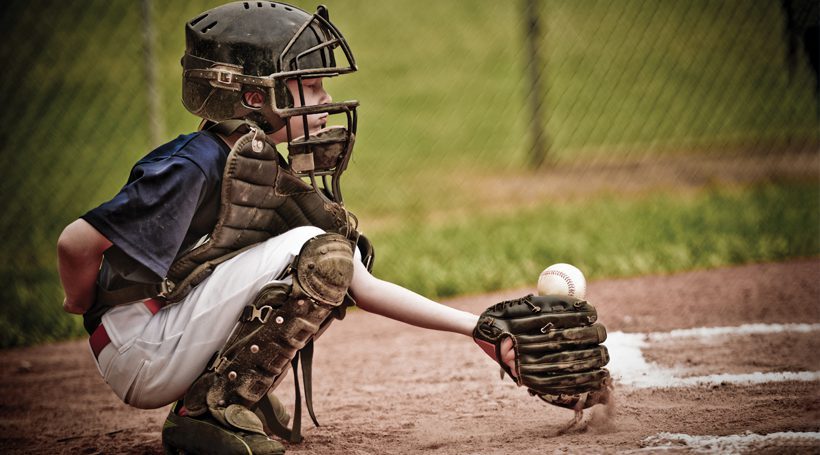
Eric Requa, DO
Sticks and stones may break bones, but so will bats, balls and pucks. For all parents, registering your child for sports comes with an uncomfortable understanding that bumps, bruises and sometimes bigger injuries might be part of the game.
Yes, accidents (and intentional fouls) happen, but there are ways to safeguard and prevent major injuries through education, sports conditioning – even for the little ones – and being in tune with your child, according to local doctors who have treated their fair share of injured young athletes.
While some injuries will heal with BandAids, TLC and a few days on the couch, others can be serious and produce long-term consequences if not properly treated, especially if they occur around a growth plate, says Eric Requa, DO, sports medicine physician at Virtua Medical Group. Tendons and muscles around growth plates are not as mature, so they are more prone to injury. What may be a mere pulled muscle for a grown up (still painful!) could mean a stress fracture for a child.
Tune in
For the most part, kids aren’t paying too much attention to getting hurt, which is a good and bad thing, says P.J. Ragone, director of Fitness Connection at Inspira Health.
“They’re just there to play the game,” says Ragone, noting that parents and coaches need to ask the right questions to make sure the knock-down or collision a kid shrugs off is really no big deal.
Injuries can be subtle, and kids may not always tell a parent they’re hurt, or even notice. A child who suddenly wants to stay home from practice may be in pain but is too worried to say anything.
“A lot of parents come to me saying, ‘My child didn’t come off the field saying he was hurt, but I noticed he wasn’t running the right way,’” says Requa.
Though it may seem obvious, “make sure to check in with your child,” says David Gealt, DO, at Cooper University Health Care. “If you see they’re throwing differently, or they’re not as active, or they’re running differently, pay attention to that.”
Ragone, who runs workshops and programs for school groups and sports teams, is trying to change the kid mentality by teaching young athletes ways to better tune into their bodies.
“Kids don’t have as much body awareness as adults do,” he explains. “Sometimes their arms and legs grow really quickly all at once, so they’re still trying to figure out how to use and articulate their limb movements. Their coordination suffers; they’re kind of all over the place for a little bit. So, in a sport, the tendency to run into someone else is higher.”

David Gealt, DO
Sports conditioning – Kids style
You don’t usually think of strength training when it comes to kids, but for children between the ages of 5 and 12, Ragone says it’s important to lay the foundation of body awareness. Think of it like laying the foundation of a house. If there’s a chance your child will focus on one sport in high school, increasing their strength in the early years is sure to help.
Note what physical deficits your children may have in the pre-season – if they lack some endurance, or their legs are a little weaker, for example – and then do some light conditioning or strength training through play, like outdoor tag, light calisthenics, or swimming. That way, they’ll be ready for the first day of practice.
For kids trying out a new sport, make sure they know the rules of the game, says Requa. And making sure to get the right equipment and protective gear is key. Even more important, make sure it fits properly.
“Rather than just signing your kid up for a sport and just sending them to practice, make sure you’re checking in every step of the way,” says Requa.
Avoiding overuse injuries
More than contact injuries, sprains and strains, overuse injuries are the most common conditions that sideline a young athlete and take the most time to heal, local sports doctors say.
Overuse issues often occur when an athlete repeats the same motion over and over, wearing down one part of the body – like pitching or swimming breaststroke. To combat that, athletes should play different sports in different seasons, take time off, or engage in other activities that use different muscles.
“Now kids are playing sports all year ’round, whether it’s off-season training or playing on multiple teams,” says Gealt. “They specialize in a sport too soon. Overusing muscles can lead to injuries that become something that plagues you long after the initial injury.”
“Even the professionals have an off-season,” adds Gealt, who has seen children as young as 7 with muscles hurt from overuse.
If your children are devoted to one sport, Requa recommends making sure they get at least six weeks off throughout the year, even if that block is divided into smaller chunks.
Parents should also let coaches know if their athlete plays on more than one team. So, if your child is on two travel baseball teams, you can prevent him from pitching two days in a row.
Endurance sports like soccer, cross country, field hockey and lacrosse, run the risk of injuries like shin splints, tendonitis and ACL tears. Upper extremity-heavy sports like softball and baseball also have a high incidence of ligament injuries, from throwing with the same arm over and over. Gealt notes that gymnasts and dancers are also at risk for overuse injuries.

PJ Ragone
More than a blow to the head
The risk of concussion is a hot concern for parents – no matter what sport their child plays. And truly there’s far more to head injuries than “having the bell rung over you,” says Gealt, noting that even a knock to the chest can move up into the brain.
“It’s all about the movement of the head,” says Requa. “If your head accelerates or decelerates really quickly, you’re at risk for a concussion.”
Both doctors agree that parents should pay attention to any possible symptoms of concussion: headaches, dizziness, nausea and feeling foggy. Symptoms may not get worse until later on, either, sometimes creeping in the next day or so.
Some doctors offer baseline concussion screening so there’s a “before” report that will be helpful “after.”
Keep it fun
Finally, check in with your children to make sure they’re having fun. Pushing kids too hard or making competition the focus when it’s not in their nature is sure to burn them out, Ragone cautions.
“If you connect fun and exercise for them,” he says, “that’s a life-long gift.”














